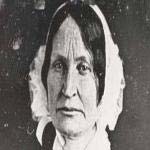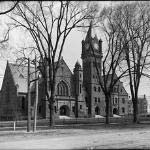
FAITH LAPIDUS: Welcome to People in America in VOA Special English. Every week at this time, we tell the story of someone important in the history of the United States. Today, Steve Ember and Shirley Griffith tell about Mary Lyon. She was a leader in women's education in the 19th century.
(MUSIC)
STEVE EMBER: During the 19th century, women's education was not considered important in the United States. Supporters of advanced education for women faced many problems.
States did require each town to provide a school for children, but teachers often were poorly prepared. Most young women were not able to continue on with their education in private schools.
If they did, they often were not taught much except the French language, how to sew clothing, and music.
Mary Lyon felt that women's education was extremely important. Through her lifelong work for education she became one of the most famous women in 19th century America. She believed that women were teachers both in the home and in the classroom.
And, she believed that efforts to better educate young women also served God. If women were better educated, she felt, they could teach in local schools throughout the United States and in foreign countries.
(MUSIC)
SHIRLEY GRIFFITH: Mary Lyon was born in Buckland, Massachusetts, in 1797. Her father died when she was five years old. For Mary, hard work was a way of life. But she later remembered with great pleasure her childhood years in the home where she was born.
This is how she described what she could see from that house on a hill:
"The far-off mountains in all their grandeur, and the deep valleys, and widely extended plains, and more than all, that little village below, containing only a very few white houses, but more than those young eyes had ever seen."
STEVE EMBER: At the age of four, Mary began walking to the nearest school several kilometers away. Later, she began spending three months at a time with friends and relatives so she could attend other area schools. She helped clean and cook to pay for her stay.
When Mary was 13, her mother remarried and moved to another town. Mary was left to care for her older brother who worked on the family farm. He paid her a dollar a week. She saved it to pay for her education. Mary's love of learning was so strong that she worked and saved her small amount of pay so she could go to school for another few months.
Mary began her first teaching job at a one-room local school teaching children for the summer. She was 17 years old. She was paid 75 cents a week. She also was given meals and a place to live.
Mary Lyon was not a very successful teacher at first. She did not have much control over her students. She always was ready to laugh with them. Yet she soon won their parents' respect with her skills.
(MUSIC)
SHIRLEY GRIFFITH: When Mary Lyon was 20 years old, she began a long period of study and teaching. A new private school opened in the village of Ashfield, Massachusetts. It was called Sanderson Academy.
Mary really wanted to attend. She sold book coverings she had made. And she used everything she had saved from her pay as a teacher. This was enough for her to begin attending Sanderson Academy.
At Sanderson, Mary began to study more difficult subjects. These included science, history and Latin. A friend who went to school with Mary wrote of her "gaining knowledge by handfuls." It is said that Mary memorized a complete book about the Latin language in three days. Mary later wrote it was at Sanderson that she received the base of her education.
STEVE EMBER: After a year at Sanderson Academy, Mary decided that her handwriting was not good enough to be read clearly. She was a 21-year-old woman. But she went to the local public school and sat among the children so she could learn better writing skills.
In 1821, Mary Lyon went to another private school where she was taught by Reverend Joseph Emerson. Mary said he talked to women "as if they had brains." She praised his equal treatment of men and women when it came to educating them.
SHIRLEY GRIFFITH: Three years later, Mary Lyon opened a school for young women in the village of Buckland. She called it the Buckland Female Seminary. Classes were held in a room on the third floor of a house.
Mary's students praised her teaching. She proposed new ways of teaching, including holding discussion groups where students exchange ideas.
Mary said it was while teaching at Buckland that she first thought of founding a private school open to daughters of farmers and skilled workers. She wanted education, not profits, to be the most important thing about the school. At that time, schools of higher learning usually were supported by people interested in profits from their investment.
STEVE EMBER: In 1828, Mary became sick withtyphoidfever. When her health improved, she decided to leave Buckland, the school she had started. She joined a close friend, Zilpah Grant, who had begun another private school, Ipswich Female Seminary.
At Ipswich, Mary taught and was responsible for 130 students. It was one of the best schools at the time. But it lacked financial support. Mary said the lack of support was because of "good men's fear of greatness in women." Zilpah Grant and Mary Lyon urged that Ipswich be provided buildings so that the school might become permanent. However, their appeal failed.
(MUSIC)
SHIRLEY GRIFFITH: Mary resigned from Ipswich. She helped to organize another private school for women, Wheaton Female Seminary in Norton, Massachusetts. It opened in 1835.
She also began to raise money for her dream of a permanent, non-profit school for the higher education of women. This school would own its own property. It would be guided by an independent group of directors. Its finances would be the responsibility of the directors, not of investors seeking profit. The school would not depend on any one person to continue. And, the students would share in cleaning and cooking to keep costs down.
STEVE EMBER: Mary Lyon got a committee of advisers to help her in planning and building the school. She collected the first thousand dollars for the school from women in and around the town of Ipswich. At one point, she even lent the committee some of her own money. She did not earn any money until she became head of the new school.

Mary Lyon opened Mount Holyoke Seminary for Women in 1837. It was in the town of South Hadley, Massachusetts. She had raised more than 12,000 dollars. It was enough to build a five-story building.
Four teachers and the first class of 80 young women lived and studied in the building when the school opened. By the next year, the number of students had increased to 116. Mary knew the importance of what had been established -- the first independent school for the higher education of women.
SHIRLEY GRIFFITH: The school continued to grow. More students began to attend. The size of the building was increased. And, all of the students were required to study for four years instead of three.
Mary Lyon was head of the school for almost 12 years. She died in 1849. She was 52 years old.
She left behind a school of higher education for women. It had no debt. And it had support for the future provided by thousands of dollars in gifts.
In 1893, under a state law, Mount Holyoke Female Seminary became a college. Mount Holyoke College was the first college to offer women the same kind of education as was offered to men.
STEVE EMBER: People who have studied Mary Lyon say she was not fighting a battle of equality between men and women. Yet she knew she wanted more for women.
Her efforts led to the spread of higher education for women in the United States. Historians say she was the strongest influence on the education of American young people during the middle of the 19th century. Her influence lasted as the many students from Mary Lyon's schools went out to teach others.
(MUSIC)
SHIRLEY GRIFFITH: This Special English program was written by Vivian Bournazian. I'm Shirley Griffith.
STEVE EMBER: And I'm Steve Ember. Join us again next week at this same time for another People in America program on the Voice of America.
typhoid: a serious infectious disease that causes fever, red spots on the chest and severe pain in the bowels, and sometimes causes death 傷寒
Woody Guthrie wrote one of America’s best loved songs
R. Buckminster Fuller, 1895-1983: building designer, engineer, inventor and poet
Madam C. J. Walker, 1867-1919: developed hair-care products for black women
(來源:VOA 編輯:陳丹妮)
